Although most people probably don’t realise it, fried pizza is actually a traditional Italian dish. It is commonly found in Naples, the birthplace of pizza. Just like other types of Italian pizza, it features classic toppings.

Pizza dough is deep-fried in a large pan with hot oil. The toppings can be added after cooking or the dough can be wrapped around them before cooking, like a Calzone.
In this article you’ll find out everything about fried pizza, including the history and origins of it. At the end of the page there’s a recipe, which you can skip to by clicking here, if you like.
In Italian, deep fried pizza is called “Pizza Fritta” – it’s a literal translation. It can mostly be found in Naples, the birthplace of pizza.

Not all pizzareias in Naples serve Pizza Fritta though, it tends to be more commonly found amongst street vendors. It does seem to be making somewhat of a resurgence in restaurants though.
Pizza Fritta in Naples in basically just deep fried pizza dough with toppings added. There are a couple of different ways it tends to be made though.
Sometimes, it can be made like a Calzone, where ingredients are sealed inside the pizza dough, before being deep fried. A variety of ingredients can be used but Ricotta cheese is often used along with some type of pork.
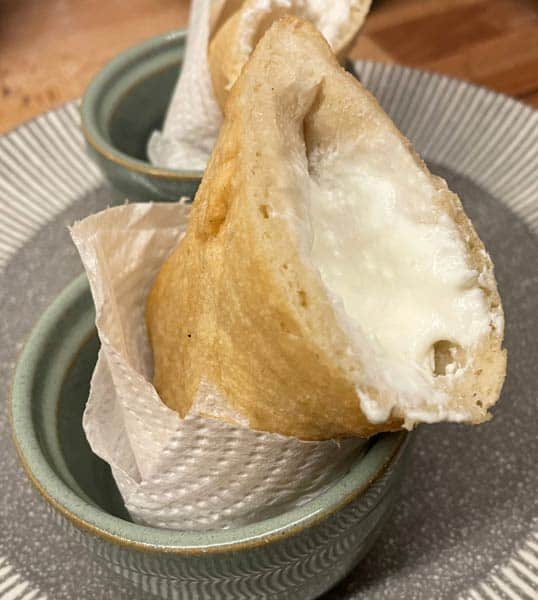
This way of serving it is more common with street vendors. The pizza can be served wrapped in paper and eaten on the go.
The alternative way of making pizza fritta is called Pizzette Fritte which translates to “mini fried pizza”. In the recipe at the bottom of the page, I include the method for both Pizza Fritte (like fried calzone) and Pizzette Fritte (like mini fried pizza).
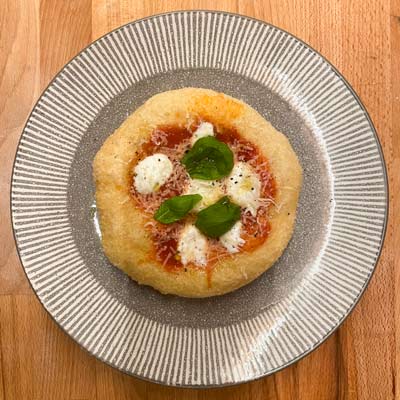
For Pizzette Fritte, a piece of dough is shaped like a small pizza and then fried without toppings. The pizza is then topped once it has finished cooking in the frier.
This more closely resembles a typical pizza and tends to be more common in restaurants. It can be eaten with a knife and fork and cut into slices to be eaten by hand.
I would recommend making Pizzette Fritte at home, at least to begin with. It’s quite an easy method with little to go wrong. This is in contrast to pizza fritta (like calzone) where you risk the dough ripping during cooking and the toppings spilling out, spoiling the oil.
Fried pizza has to be the best way to make pizza without an oven. In fact, the lack of an oven is arguably one of the main reasons for the popularity of fried pizza or “Pizza Fritta” in Naples.
Fried pizza saw a resurgence in Naples following the second World War. A lot of pizza ovens were destroyed in the bombings so fried pizza became a common alternative. Also, cheaper toppings tended to be used, such as Ricotta cheese (not necessarily cheap today though), which is a byproduct of the Mozzarella making process.
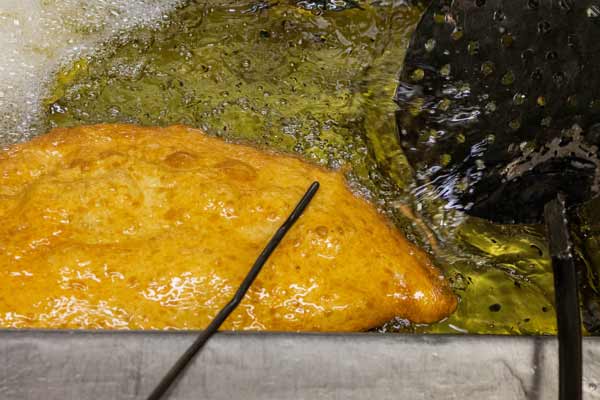
Contrary to popular belief, though, it seems unlikely that fried pizza was invented in the 1940s. In fact, there are refrences to fried dough in Italian recipe books dating back to the 1500s (source). It seems more likely that fried pizza simply became more popular due to necessity (cost and availability of pizza ovens).
Fried raw pizza dough is exactly what Pizza Fritta is – the traditional Italian style of pizza. Part of the beauty of making fried pizza at home is that you can just use your regular pizza dough.
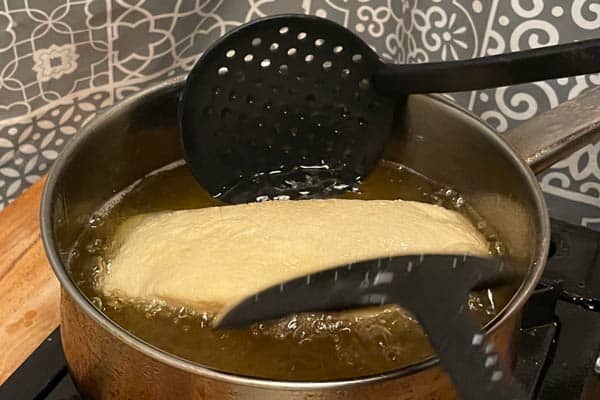
All you need to do is to make sure the dough is proved, as normal. There’s no need to make any changes to the way you prepare the dough and there’s no need to cook the dough in any way before frying.
The only difference I would recommend with fried pizza dough is to use a small dough ball size. I typically use around 175g instead of 250g to 275g for a normal pizza. This should ensure that the dough comfortably fits inside a large pan.
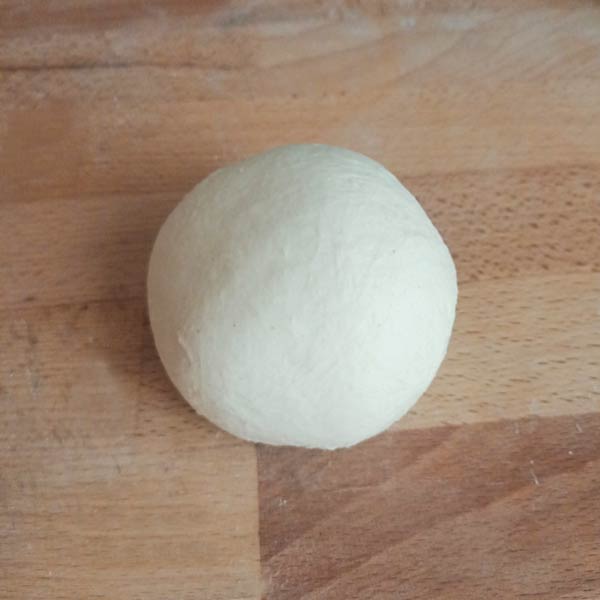
You can make dough especially for fried pizza or you can make extra dough to give it a try the next time you make normal pizza. Why not do a taste test and see what the difference is? You may be surprised just how different the same dough can taste.
Another great option is to make fried pizza with leftover dough the next day. Simply reball your leftovers, seal them up, and refrigerate them. Remove them from the fridge the following day a few hours before and you’re good to go.
The main difference with fried pizza dough is probably the taste. This may sound surprising, but the dough typically tastes significantly sweeter, even without added sugar.
This is probably why many people have taken to frying the dough for dessert pizza. The sweeter dough can work well with sweet toppings. Stay tuned for my dessert pizza recipe, which is coming soon!

Having said that, the sweeter dough also works great with savoury toppings. You get a subtle sweetness without overpowering the savoury flavours.
The other surprising quality of fried pizza, at least for me, is that it’s very light. You might expect it to produce a heavy dough but when done properly, it is soft, light, and easy to eat.
Well made Pizza Fritta has a naturally sweet flavour with a cripy outside but a very soft interior. It’s actually delicious when eaten plain, but it is elevated with quality toppings.
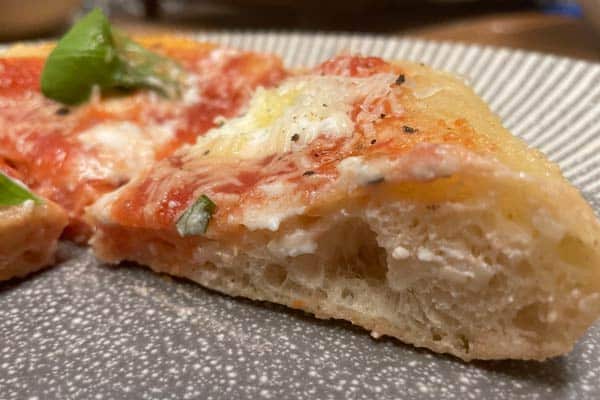
Personally, I would recommend trying it with very simple toppings first so you can see how it differs in flavour to a normal pizza. But of course it’s up to you how you experiment with the toppings!
Fried pizza is typically cooked in a large, deep pan with plenty of oil in it. Two long spatulas or slotted spoons are usually used in order to turn the dough.
With the correct oil temperature, the dough should float on the oil. As it cooks, the spoon is used to douse the top of the dough with oil. This ensures that the top of the dough cooks as well as the bottom.
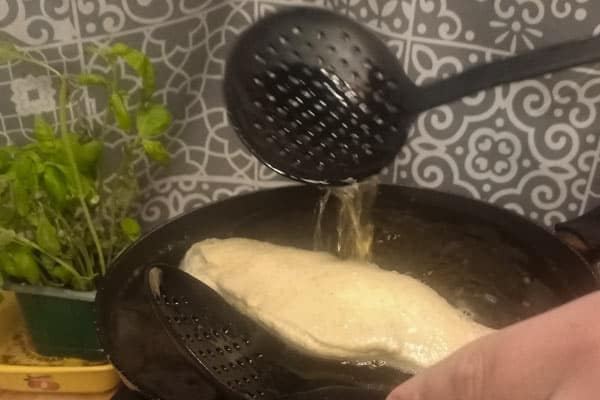
The dough is typically flipped once or twice to ensure even cooking. It is removed from the oil when it is golden, crispy, and evenly cooked on both sides.
The cooked dough is usually set on a wire rack, or kitchen paper, to drain. The pizza can also be patted dry with some kitchen paper in order to remove any excess oil.
Peanut oil (also known as groundnut oil) is one of the most commonly used oils for fried pizza. The benefit of this oil is that it has a higher smoke point than olive oil, which allows higher temperatures to be reached during frying. It also provides some depth of flavour to the dough.
A good alternative to peanut oil is rapeseed oil, which is also known as canola or vegetable oil. This oil is cheap and readily available, and has a high smokepoint like peanut oil. The downside (or upside depending on your preference) is that rapeseed oil doesn’t contribute much flavour.
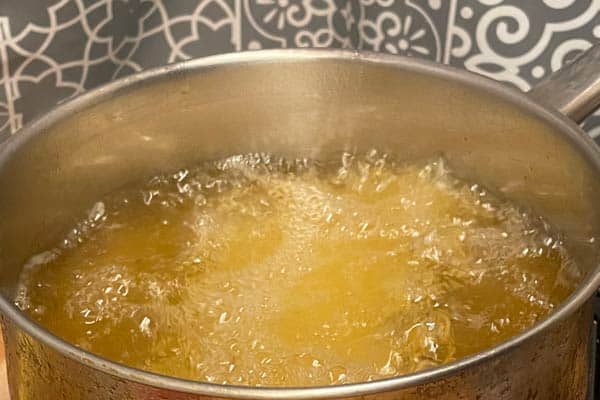
Another option is to mix olive oil and rapeseed oil in a roughly 50:50 mixture. This provides the flavour of the olive oil but with an increased smokepoint, which allows for better frying of the dough.
I wouldn’t recommend frying in just olive oil since it will probably start to smoke as you reach the required temperature.
The temperature of the oil is key to making great Pizza Fritta, or fried pizza. It is generally recommended that a temperature of between 190C/375F to 205C/400F is used.
Any lower than this temperature window, and the dough won’t cook properly – it won’t brown and become crispy on the outside. Any higher than this and you risk the oil smoking and the dough burning.
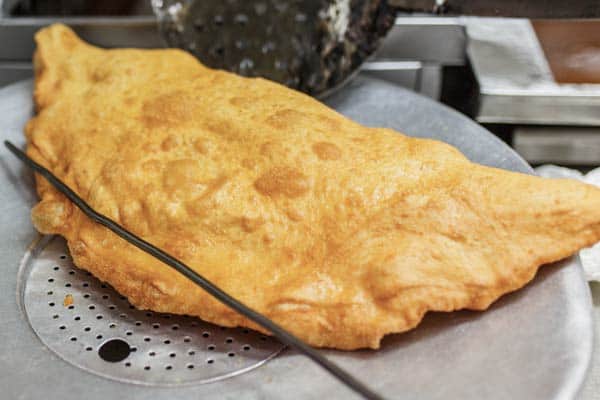
To be clear, this is a high temperature, which is why careful selection of the oil is required. You can always check the smokepoint of your oil – it should be comfortably higher than 205C/400F.
You should always use a thermometer, not only to ensure the correct temperature for cooking, but also for safety reasons. The temperature of the oil should never get too high. It is also important to never leave the oil unattended while cooking.
If your oil begins to smoke, the temperature is too high for the oil. Simply turn it down or turn it off until the temperature reduces and the oil stops smoking.
Pizza dough should be fried until it is golden and crispy on the outside. At the recommended temperature of between 190C/375F to 205C/400F, the cooking should take around 60 to 90 seconds per side.
Be sure to allow the fried pizza to drain (and cool) for at least a minute or so before serving.
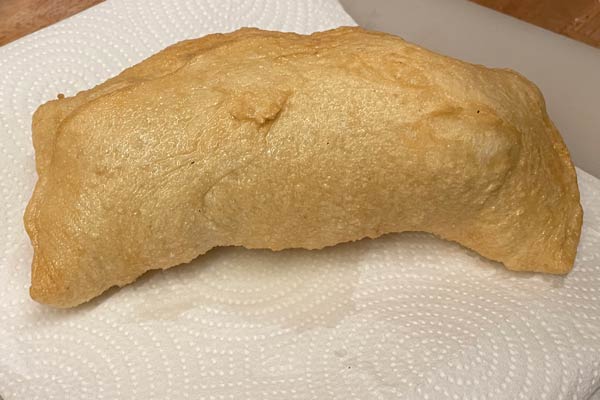
Check out the recipe for pizza fritta below. It’s really easy and it doesn’t even require an oven, let alone a pizza oven! What’s more, it’s delicious.
If you’ve never tried fried pizza before, I think you’ll be surprised. When made well, it’s very light and tasty, it’s not at all greasy and heavy, as you might suspect.
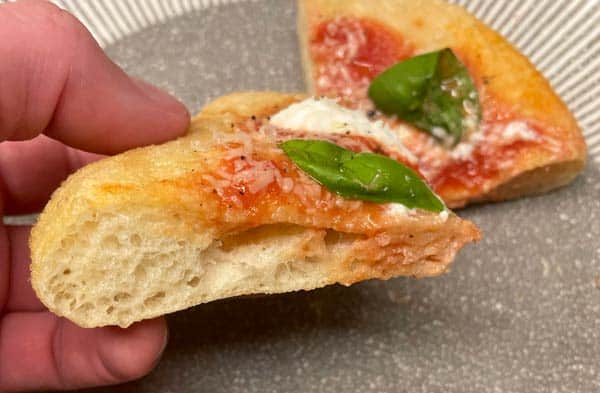
Also, this pizza fritta recipe is a great one to show your friends. Chances are they’ve never heard of it and they’ll be amazed with the results.
With that being said, let’s get into the recipe!
Authentic Neapolitan Fried Pizza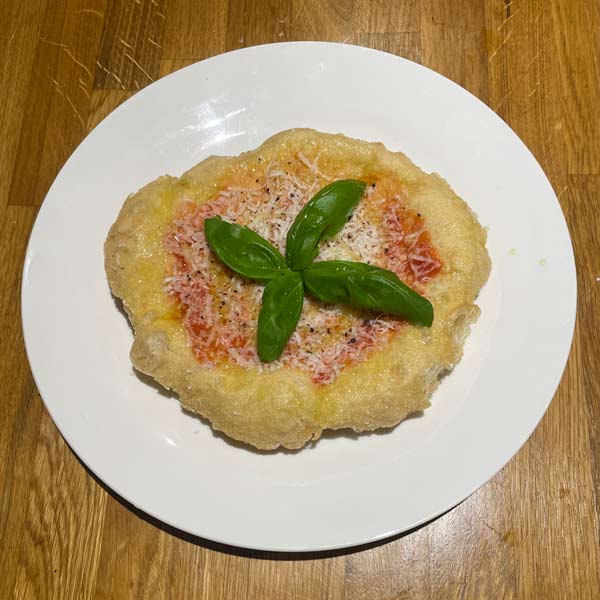
With this recipe, you can make traditional Neapolitan style fried pizza. Just use normal pizza dough, you can even use leftover dough.
If you’ve never made pizza dough before, check out my pizza school series here. There you’ll learn how to make pizza from start to finish, with lots of detailed information and videos.
Important Notes:
Do not skip over the following notes before continuing to the recipe.
Makes 4 x 175g pizzas.
For more detailing information on making the dough click here for my article (with a video).
Note: Caputo 00 pizza flour is an excellent option, especially for Neapolitan style pizza. It is one of the more widely available “professional” pizza flours. Click here to check the price on Amazon. Aside from this flour, most 00 flours should work fine.
Fill a large, deep pan with oil. Do not fill right to the top, leave a few inches for safety. A deep frying pan can be used but a deeper pan (saucepan) is safer. Alternatively, a deep fat fryer is probably the best option – it is safer as it will maintain a constant temperature for you.
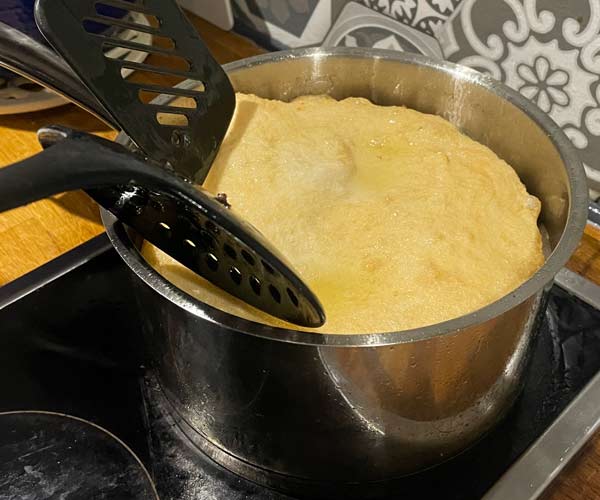
Using a large saucepan is probably a safer option than a frying pan
You will require:
I recommend any of the following types of oil:
Note:
Feel free to experiment with toppings. I have kept it simple with the following recommendations, which should be enjoyable for everyone.
Toppings for pizzette fritte (ingredients)
For pizzette fritte (like mini fried pizza) I have copied the ingredients used in a classic Margherita, but with parmesan instead of mozzarella. When added afterwards, the mozzarella can become watery if it is not dry enough or fine enough. I recommend getting comfortable with just parmesan before trying it with mozzarella.
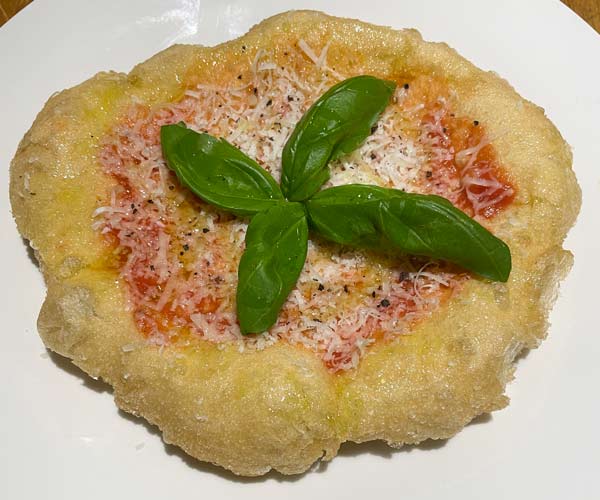
Pizzette fritte with parmesan
Toppings for pizza fritta (ingredients)
For pizza fritta (like fried calzone) I have kept the toppings as simple as possible, using just ricotta cheese (this is often used traditionally). Without any more toppings, the chance of the dough ripping is reduced. With practice, you can start adding more ingredients if you like. Pork scratchings or fried pork are often added along with the ricotta traditionally.

Pizza fritta with just ricotta sauce
Not all the following utensils are required but these are what I use and they tend to make the process much easier.
Any large bowl could be used for mixing the dough but I like using the metal ones since they’re lightweight, stackable, and easy to clean.
Click here to check out metal mixing bowls like the ones I have on Amazon.
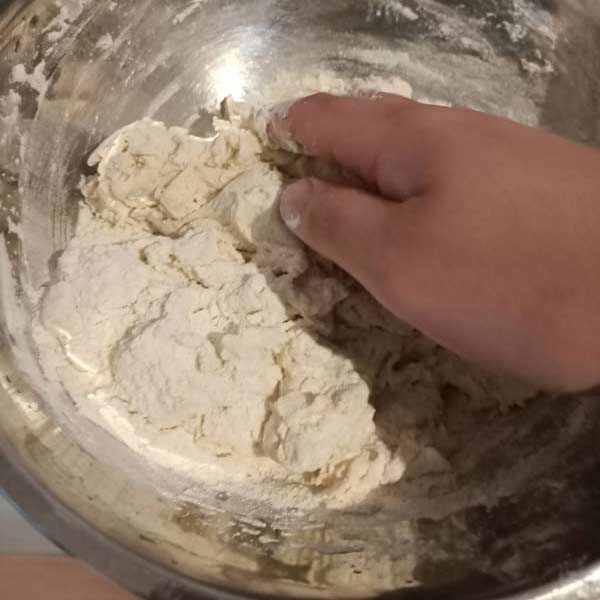
These are affordable, easy to use, and precise (accurate to 1g). I don't recommend using cups as measurements as they are inprecise.
Click here to take a look at the type of digital scales I use on Amazon.
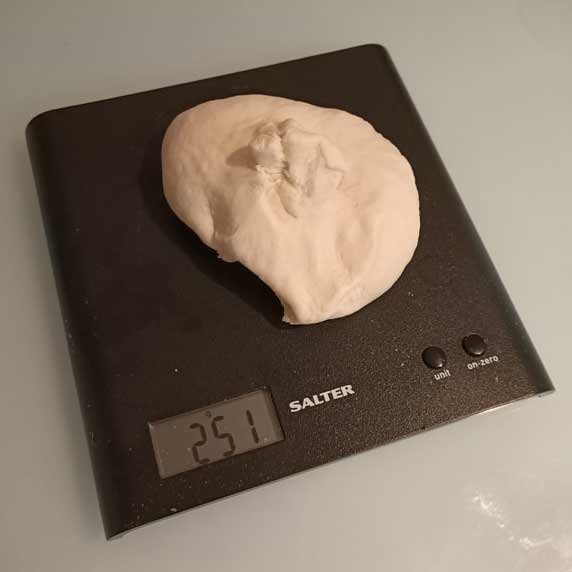
These kitchen scales are accurate to 0.01g and are perfect for measuring the tiny amounts of yeast needed for long proves.
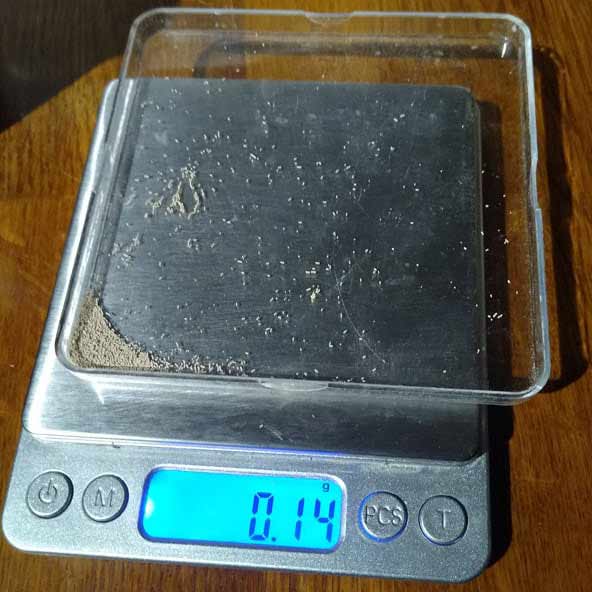
Pizza proofing boxes are an excellent investment. They are airtight and they make taking the dough out for shaping very easy.
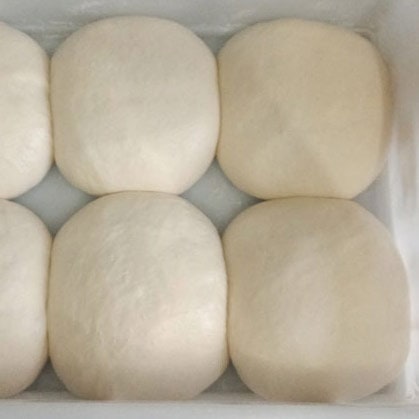
A digital thermometer (ideally wired) allows you to monitor the temperature of the oil, ensuring it is within the ideal range.
Click here to check out a digital wired thermometer similar to the one I use on Amazon.


Fortunately, the same dough (including dough weight) can be used for both pizzette fritte and pizza fritta. Simply make your normal Neapolitan dough but use a dough weight of around 175g.
For a detailed recipe, check out my article (with a video) on mixing dough here. Alternatively, use the simplified directions below:
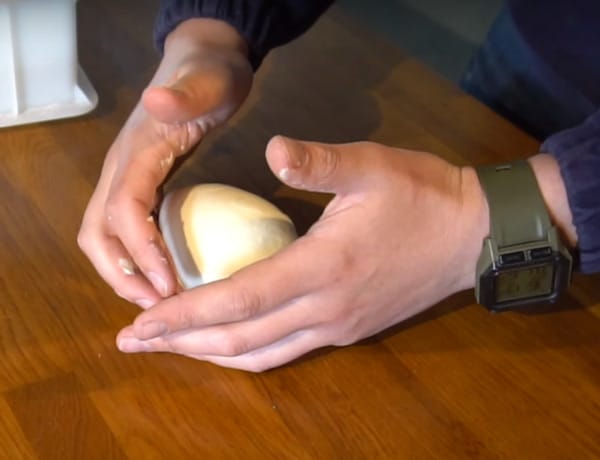
First I’ll cover the preperation of toppings for pizzette fritte, and then for pizza fritta.
Toppings for pizzette fritte (method)
Follow the steps below to prepare some simple toppings for pizzette fritte (mini fried pizza).
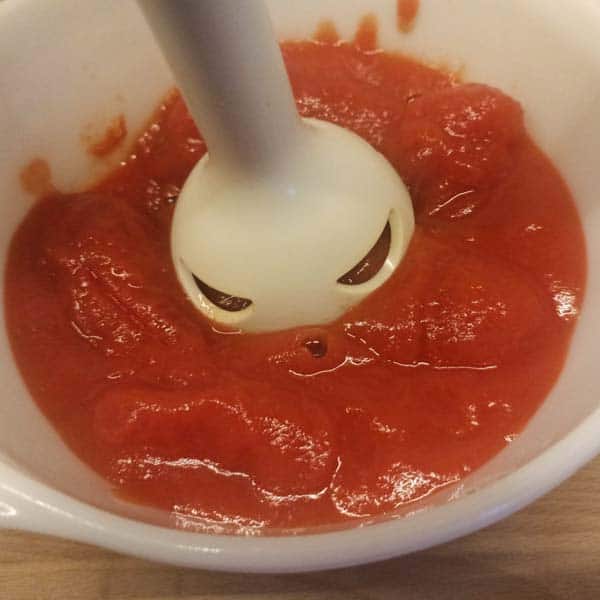
Toppings for pizza fritta (method)
Follow the steps below to prepare a simple ricotta sauce for the pizza fritta (like fried calzone).
Follow the steps below for both pizzette fritte and pizza fritta.
Shaping pizzette fritte
For mini fried pizzas, the method is pretty easy.
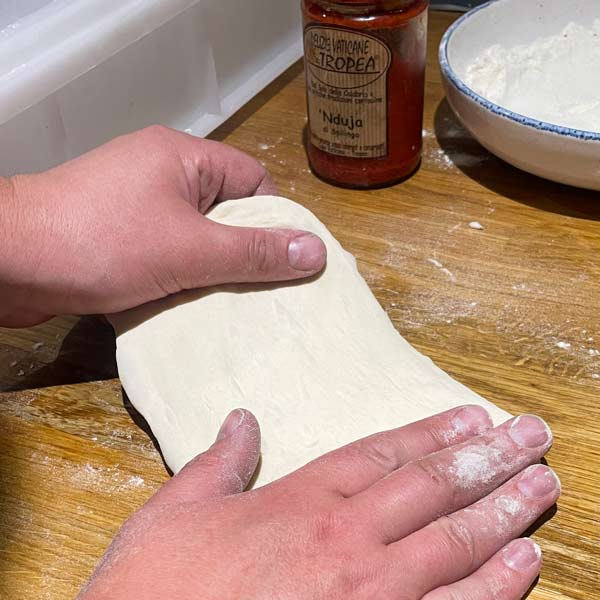
Shape as normal but ignore the crusts
Shaping pizza fritta
This calzone style fried pizza is trickier to shape so I’d recommend becoming condifent with the mini pizzas first.
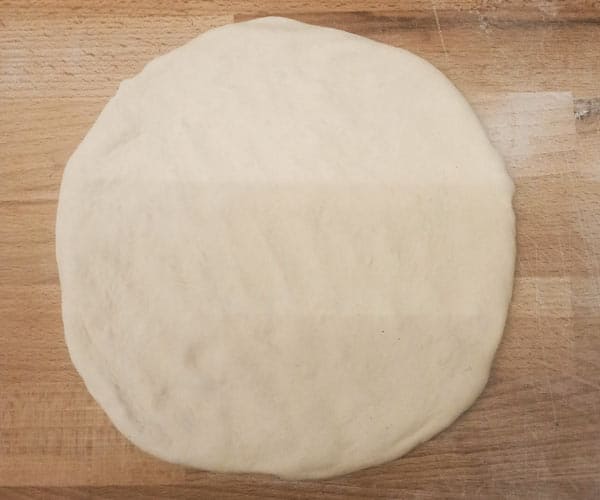
Stretch the pizza out quite large but with no crust
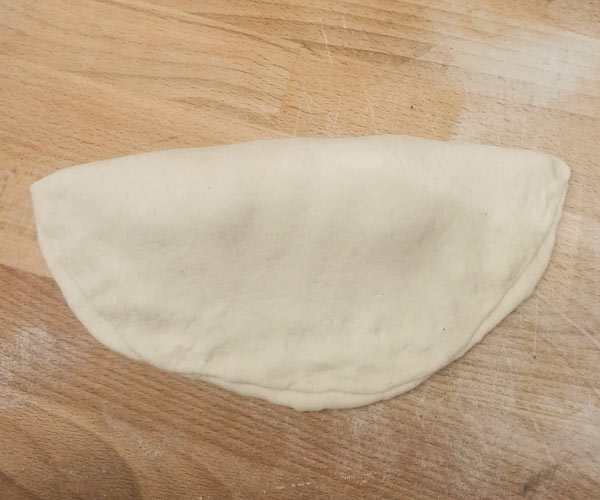
Press the edges together, forming a light seal initially
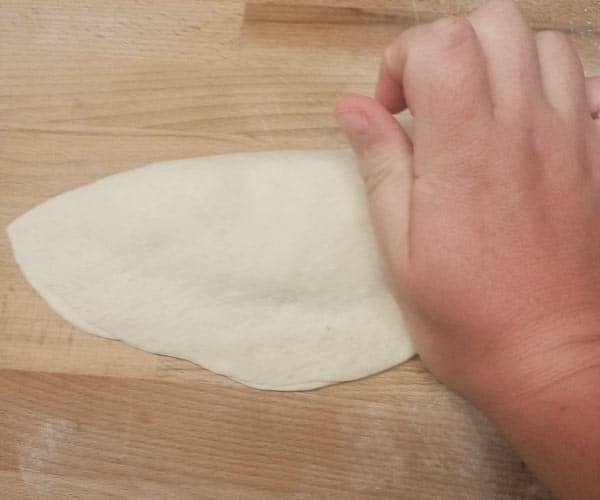
Use the heel of your hand to create a firm seal
Follow the directions below for both pizzette fritte and pizza fritta.
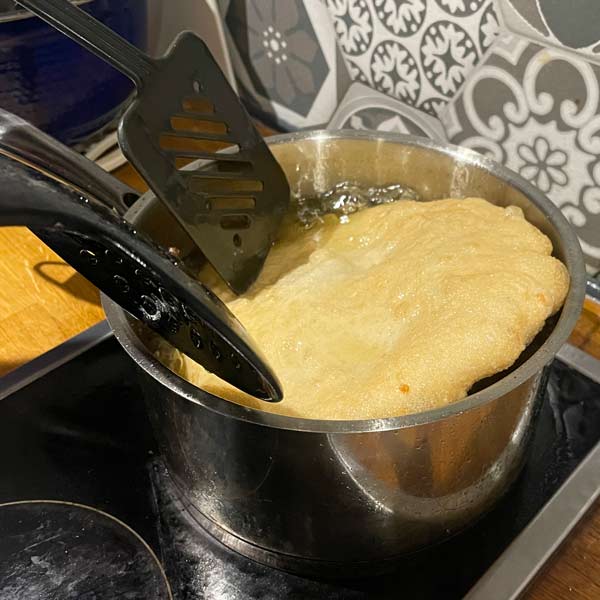
Turn the dough slowly and carefully

Use a slotted spoon to baste the dough, if you have enough space in the pan
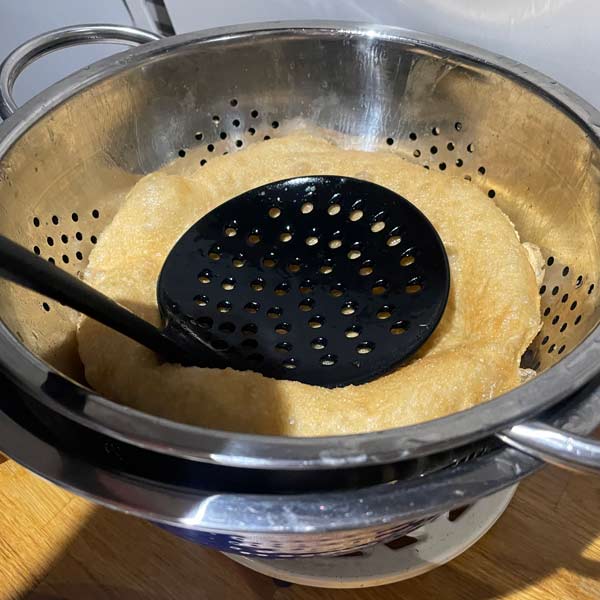
This is how I drain my fried mini pizzas. I also like to push down a little in the middle of the pizza to allow for the toppings.
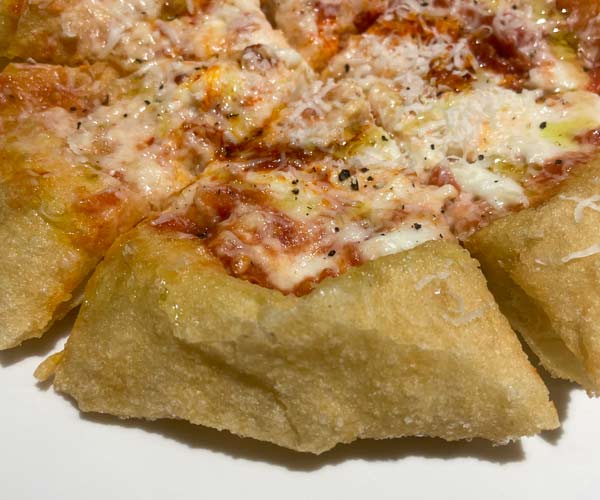
Here’s one I made earlier, with mozzarella and nduja!
IMPORTANT NOTE: Always monitor the oil temperature and don’t allow it to get too hot (above around 210C/410F). The oil will probably cool slightly as dough is added and heat us once it is removed.
Overall recipe notes
Most people I speak to have never heard of fried pizza, and they’re surprised when I tell them it’s a traditional Italian dish. Initially, they probably think it sounds unpleasant, until they try it that is!
When done well, fried pizza truly is delicious. Just like Neapolitan pizza that’s cooked in a wood fired oven, fried pizza is crisp on the outside and soft on the inside.
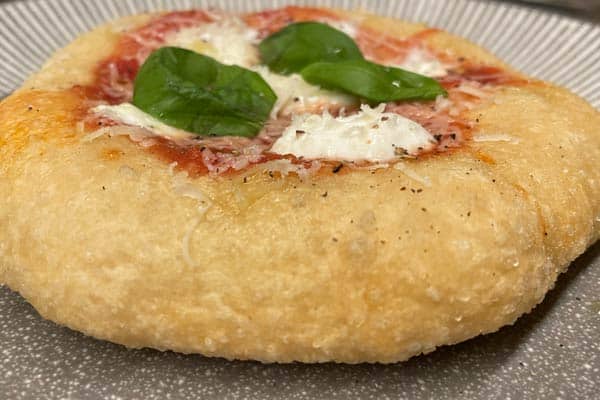
A delicious Pizzette Fritte (mini fried pizza) I made earlier!
It’s the pefect option for any time you don’t have access to an oven. Also, it makes a pleasant change from “normal” pizza.
I hope this article has encouraged to give fried pizza a try, you may just fall in love!
Be sure to leave a comment below, I’ll try to answer any questions as best as I can. Also, feel free to leave a rating in your comment.
Good luck!

I’m Tom Rothwell and I’m super passionate about all kinds of homemade pizza! In the last few years I've been on a quest to find the perfect pizza. Now I'm sharing what I've found out with the world!

If you're interested in hiring me for your event in the UK, feel free to check out my website with the link below.
Pizza Catering
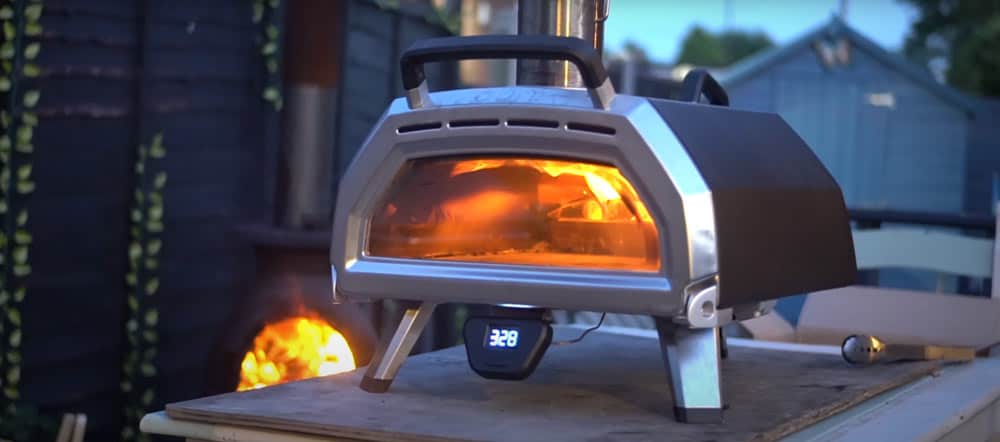
I often get asked what type of oven I use for my pizzas. Well, I use a pizza oven made by a company called Ooni.
The range of pizza ovens that Ooni offers is just brilliant. They cover all bases, and all price points. There's affordable and portable models such as the Fyra 12 Pizza Oven and then there's state-of-the-art models such as the Karu 16 Pizza Oven pictured below.
In all honesty, I would say that the oven makes a huge difference. If you're looking to make authentic Italian pizza, a pizza oven is a must.
By clicking the link below and purchasing from Ooni, you would be supporting this website. I've been using their ovens for a long time now and I wouldn't recommend them if I didn't believe in their products.
Time to make some amazing pizza!

I’m Tom Rothwell and I’m super passionate about all kinds of homemade pizza! In the last few years I've been on a quest to find the perfect pizza. Now I'm sharing what I've found out with the world!

If you're interested in hiring me for your event in the UK, feel free to check out my website with the link below.
Pizza Catering